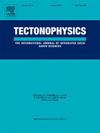埃塞俄比亚主裂谷中部构造与岩浆分割的相互联系
IF 2.7
3区 地球科学
Q2 GEOCHEMISTRY & GEOPHYSICS
引用次数: 0
摘要
埃塞俄比亚主裂谷(MER)呈现出从南部的大陆裂陷萌芽到北部的早期海洋扩张的裂谷板块演化谱。中部板块相对不成熟,其特征是通过边界断裂、轴向岩浆段和裂谷外岩浆带调节应变。然而,对该区构造和岩浆分割的认识相对不完整。本文在地壳尺度上研究了CMER,利用重力数据分析了构造分割(TS)的性质。虽然以前的研究只考虑了CMER中的Aluto-Gedemsa岩浆段(MS),但我们的工作首次绘制了三个不同的MS: Tullu mooe - gedemsa -MS, Aluto-MS和Corbetti-Shalla-MS,基于使用重力数据的地下成像。研究发现,在Tullu Moye-Gedemsa和Boseti-Kone MS内,地表断裂的分布与地下岩浆侵入带有关,表明构造与岩浆分割之间存在明显的相互联系,表明该地区处于TS阶段。相比之下,在Corbetti-Shalla和Aluto-MS地区没有这种联系,这表明CMER的南段可能没有处于TS阶段。本文章由计算机程序翻译,如有差异,请以英文原文为准。
Tectonic and magmatic segmentation interlinkage in the central main Ethiopian rift
The Main Ethiopian Rift (MER) presents a spectrum of rift sector evolution from embryonic continental rifting in the south to incipient oceanic spreading in the north. The central sector of the MER (CMER) remains relatively immature, characterized by strain accommodation through border faults, axial magmatic segments, and off-rift magmatic zones. However, understanding of the tectonic and magmatic segmentation within this sector is relatively incomplete. This study investigates the CMER at a crustal scale, utilizing gravity data to analyze the nature of tectonic segmentation (TS). While previous studies only considered the Aluto-Gedemsa magmatic segment (MS) within the CMER, our work maps three distinct MS for the first time: Tullu Moye-Gedemsa-MS, Aluto-MS, and Corbetti-Shalla-MS, based on subsurface imaging using gravity data. We find that the distribution of surface faults correlates with subsurface magmatic intrusion zones within the Tullu Moye-Gedemsa and Boseti-Kone MS, indicating a clear interlinkage between tectonic and magmatic segmentation and suggesting the TS stage of the region. In contrast, the absence of such association in the Corbetti-Shalla and Aluto-MS regions suggests that the southern section of the CMER may not be in a stage of TS.
求助全文
通过发布文献求助,成功后即可免费获取论文全文。
去求助
来源期刊

Tectonophysics
地学-地球化学与地球物理
CiteScore
4.90
自引率
6.90%
发文量
300
审稿时长
6 months
期刊介绍:
The prime focus of Tectonophysics will be high-impact original research and reviews in the fields of kinematics, structure, composition, and dynamics of the solid arth at all scales. Tectonophysics particularly encourages submission of papers based on the integration of a multitude of geophysical, geological, geochemical, geodynamic, and geotectonic methods
 求助内容:
求助内容: 应助结果提醒方式:
应助结果提醒方式:


